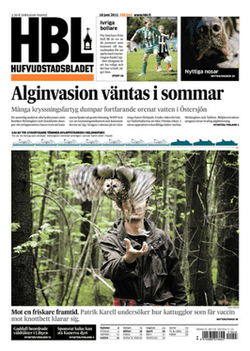Hufvudstadsbladet
Hufvudstadsbladet (abbr. Hbl) is the highest-circulation Swedish-language newspaper in Finland. Its headquarters are located in Helsinki, the capital of Finland.[1] The name of the newspaper translates approximately into "Journal of the Capital",[2] hufvudstad (modern spelling huvudstad) being 19th-century Swedish for capital. The newspaper is informally also called Husis or Höblan.
 Hufvudstadsbladet front page, 10 June 2011 | |
| Type | Daily newspaper |
|---|---|
| Format | Compact |
| Owner(s) | Föreningen Konstsamfundet Association |
| Publisher | KSF Media |
| Editor | Jens Berg |
| Founded | 1864 |
| Language | Swedish |
| Headquarters | Helsinki |
| Circulation | 36,719 (2014) |
| Website | www.hbl.fi |
History and profile
Hufvudstadsbladet was founded by August Schauman in 1864,[3][4] and the first edition was published on 5 December the same year. During the late 19th century, the paper was the highest-circulation newspaper in Finland.
In 1920 the company Hufvudstadsbladets Förlag och Tryckeri AB was founded to operate the newspaper. The company's principal owner and chief executive officer was Amos Anderson, who would also serve as editor-in-chief of the newspaper between 1922 and 1936. Konstsamfundet (approx. The Art Foundation), founded by Andersson in 1940, took over ownership of Hufvudstadsbladet in 1945, and has wholly owned the newspaper since.
Hufvudstadsbladet has an independent and liberal stance.[5] It is owned by Foreningen Konstsamfundet Association[5] and is published by the KSF Media Group.[6][7] The group also publishes Västra Nyland, Östra Nyland, Hangötidningen, Borgåbladet and Loviisan Sanomat.[8]
In the Spring of 2004 Hufvudstadsbladet changed its format from broadsheet to tabloid.[9][10] In the same year it became Finland's tenth highest circulating newspaper.
In 2006 Hufvudstadsbladet was named Europe's Best Newspaper and awarded European Newspaper Award in the category of local paper plus.[9]
A weekly supplement called Vision (television and radio programming information) is distributed with the newspaper on Thursdays. From August 2006 to May 2010 Hbl also published a full-colour weekly magazine called Volt with focus on lifestyle, features and photography. During its existence Volt was awarded more than 30 design prizes, much thanks to the visionary skills of AD Jesper Vuori.
In January 2014 Hufvudstadsbladet started a digital evening edition, Hbl Kväll, which is updated daily at 4 pm.[8]
Circulation
In 1900 Hufvudstadsbladet had a circulation of 17,500 copies.[11] However, in the 1920s its circulation fell behind Helsingin Sanomat and the gap between them continued in favor of the latter.[11]
In 1996 the circulation of Hufvudstadsbladet was 59,206 copies.[12] The paper had a circulation of 36,719 copies in 2014.[13]
References
- "Finland country profile". BBC. 7 March 2012. Retrieved 8 January 2015.
- Svennik H⊘yer (2003). "Newspapers without journalists". Journalism Studies. 4 (4): 451–463. doi:10.1080/1461670032000136550.
- The Europa World Year Book 2003. Taylor & Francis. 10 July 2003. p. 1613. ISBN 978-1-85743-227-5. Retrieved 20 November 2014.
- Oskar Bandle; Kurt Braunmuller; Ernst-Hakon Jahr; Allan Karker; Hans-Peter Naumann; Ulf Teleman (2005). The Nordic Languages 2: An International Handbook of the History of the North Germanic Languages. Walter de Gruyter. p. 1487. ISBN 978-3-11-017149-5. Retrieved 24 November 2014.
- "Hufvudstadsbladet" (PDF). European Association of Daily Newspapers in Minority and Regional Languages. Archived from the original (PDF) on 20 December 2014. Retrieved 20 December 2014.
- Jyrki Jyrkiäinen (2009). "Newspaper Chains in Finland 1993–2010". Journal of Media Business Studies. 9 (2): 7–25. doi:10.1080/16522354.2012.11073541.
- "Hufvudstadsbladet". Publicitas. Retrieved 20 December 2014.
- Lars Ørhøj (31 January 2014). "Record Readership for Digital Evening Paper". Visiolink. Retrieved 7 January 2015.
- "Europe's most innovative newspaper 2006: De Morgen". Oberauer. 17 November 2006. Retrieved 6 March 2015.
- "From Broadsheet to Tabloid" (PDF). University of Tampere. January 2014. Retrieved 19 December 2014.
- Kenneth Douglas McRae; Mika Helander; Sari Luoma (1999). Conflict and Compromise in Multilingual Societies: Finland. Wilfrid Laurier Univ. Press. p. 315. ISBN 978-0-88920-347-1. Retrieved 20 December 2014.
- "Swedish in Finland". Universitat Oberta de Catalunya. 17 April 1998. Retrieved 7 January 2015.
- "Circulation Statistics 2014" (PDF). Levikintarkastus Oy - Finnish Audit Bureau of Circulations. Archived from the original (PDF) on 30 May 2015. Retrieved 30 May 2015.
External links
- Hufvudstadsbladet's website (in Swedish)
- Office for Newspaper Design